
Ideally, advertising should attract the attention of prospective consumers and convince them to use your product to position your company’s message. Ad optimization is a critical component of every healthy, effective advertising strategy.
It’s a crucial skill, and mastering it might take a long time and a lot of mistakes. However, imagine the possibility of optimizing your advertising depending on your users’ intent and automatically sending it to them. That is what the newest advertising kind, dynamic product ads, can assist you in achieving.
In this post, we’ll go through dynamic product ads and how to use them to your advantage. So, let’s dive in!
What are dynamic product ads?
Dynamic product ads are ads campaigns that change automatically based on users’ activities on your website, app, business page, etc.
In other words, when someone visits your website, the Facebook pixel is triggered. That means the platform starts collecting data. When running dynamic product ads, you can target these individuals with relevant products depending on particular activities you select, such as specific products seen or added to the cart by users.
Dynamic product ads allow you to market relevant items to your customers or anybody who has browsed your products on your website or mobile app. Both Google and Meta (Facebook, Instagram, etc.) offer dynamic products ads. You’ve certainly seen enough of these advertisements on your Facebook feed, but here’s an example from Alibaba to refresh your memory.
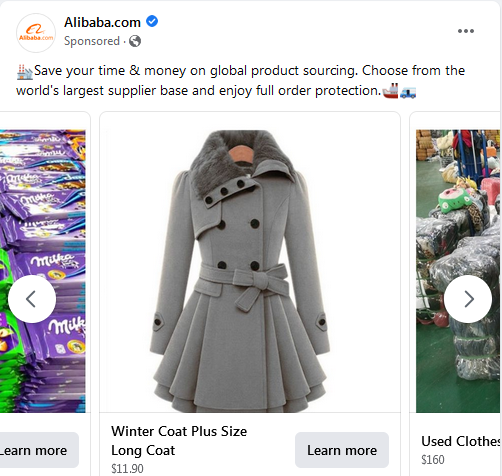
There are three main types of dynamic product ads:
DPA for the same product: Assume a potential consumer comes to your website and looks at one of your products. You may target the same person with DPA based on the items they saw.
A cross-selling DPA: It displays items similar to those that a consumer has previously purchased.
Upsell DPA: Targets consumers who have added products to their card, usually by bundle offers.
Instead of generating an ad for each product separately, you develop an ad template that automatically uses details from your data sources for the products you want to advertise.
Why should you use dynamic product ads?
Dynamic product ads enable you to build ad units for ads using content and photographs from your product catalogs rather than manually for all other ad units. For instance, if you operate a general store with thousands of items, you would most likely need to run a thousand different campaigns for each one to advertise them. DPA advertising is simple to set up, and they promote all of your items automatically, so you can almost forget about them.
It’s a terrific approach to boost your customer’s lifetime value by showing them ads for things they’re also likely to be interested in purchasing. You just set it up, and it will automatically display advertising to users that match your criteria.
Dynamic product ads may also help you increase your average order and lifetime value. Specifically, cross-sell and upsell campaigns. If you retarget them with a hyper-targeted marketing message based on their interests, they’re more likely to remember that product and buy it.
Dynamic product ads help you provide consumers who have already purchased from your business things that may boost the consumer’s lifetime value. In short, you have them buy from your store more than once. Assume someone was about to purchase a product from your business for $30. You could target that one with dynamic product ads for a bundle deal worth about $60, thus doubling the order value.
6 tips to help you create dynamic product ads that work
If you’ve ever run a Facebook ads campaign based on traffic conversions or anything similar, you’ll recognize the process when trying to build these dynamic product ads. So, for the most part, we won’t go into detail. Instead, you’ll have a better understanding of making these ads more effective.
Here are some tips to boost the effectiveness of your dynamic product ads.
1. Create product sets
The “product sets” option allows you to target a specific audience based on their interests. It’s useful when you don’t want to promote all items to all audiences; instead, you may filter items based on category, product type, currency, product availability, among other things.
Product sets keep your consumers up to date, leaving an impact on audiences. They make your message easier to remember and urge consumers to take action. Assume you want to show products that cost less than $500, or consider whether you have a holiday collection or anything similar, such as a memorial day. In these situations, you should use product sets. They are so powerful, especially in upsell and cross-sell efforts.
Product sets also allow you to control which products will benefit from the promotion. Goal-based product sets based on special discounts and new arrivals, for example, might be used to reach out to consumers who have added products to their cards (upselling strategy).
2. Do not overlap your ads
When you start scaling your campaigns or duplicating ad sets to target new leads, your audience will eventually overlap, and your ad sets will either stop spending or explode in cost. For instance, when two people share the same data, you use the same interest on the same campaign budget optimization. Advertising reaches a point where they overlap, and your campaigns stop performing.
So, you need to remove some of these interests or audiences. If you have multiple audiences in your ad account, you should determine whether any audience overlaps between two separate groups. You may use the Facebook audience overlap tool to compare several audiences at once and see the proportion of users who overlap. You can see how it looks in this image.

It may also be frustrating for the same person to receive multiple ads. The most significant problem is that both ads may start bidding against each other.
An example is if you run one ad that targets your website visitors and another that targets your email subscribers. Your website visitors would start seeing your email subscribers’ ads, and the email subscribers audience would start seeing website visitors’ ads, which is something you do not want.
So, make sure there are minimal overlaps between your target groups. Track them each time you run advertising.
3. Optimize for the app shopper
Since people who use apps to shop are on the rise, you should target app shopping audiences to ensure you’re targeting the most likely people to convert. You may target them based on in-app behavior on Facebook or Instagram, particularly audiences who have clicked on the shop now button.
In dynamic product ads, you may use the “engaged shoppers” option as behavior or criteria to target audiences who have shopped from apps.
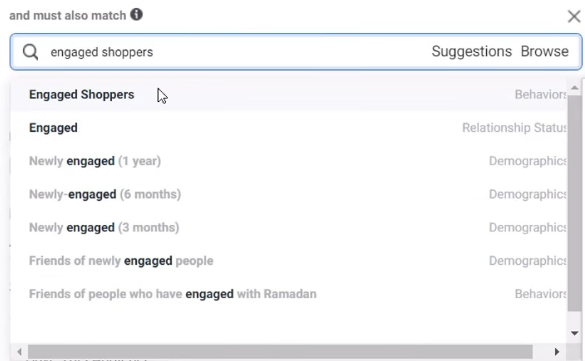
It is more beneficial if you have physical products, such as jewelry, apparel, or clothing. But, if you are selling something that is perhaps more particular to your target, such as a B2B product, it is typically not beneficial to include engaged shoppers.
4. Tailor the campaign to your budget
It’s crucial to specify the desired outcome of your ads: generate clicks, impressions, or conversion. It’s not a goodidea to put all of your ad spendings into one goal.
You’ll need to figure out how many different types of advertising you can afford. For instance, divide your budget strategy into two main categories: Spend part of your advertising on an annual branding effort to develop credibility and name recognition in your target market. The rest spend it on extra advertising during seasonal opportunities. Keep in mind that the money you spend on advertising is a long-term investment in your company’s growth. So, make sure your advertising design, content, and intent is perfectly planned for your expectations.
The key to success is consistency and continuity. So, you should invest the time to create a strategy for your budget. In most cases, new businesses begin with an annual advertising budget. The budget should be sufficient to cover 52 consistent weeks of advertising.
5. Improve your creatives
The creatives tool impacts the visuals that appear in your ads. It enables you to group several ads with different creative elements such as color palette, text font, and graphics for distinct target groups.
Choose the proper form that fits your business based on how your brand feels, which one you like most, and which one you believe works best with your image. There are several alternatives accessible to you. You may also put catalog metadata in your photos. Price strikethrough, price percentage off, and free shipping are all options.
You have the option of selecting the typeface that you will use. Choose based on your branding or which one you believe looks better. Fashion and Friends, for example, use creative elements like price percentage off, color palette, and text type to customize their photo templates and suit their brand feel in this Instagram dynamic product advertising.
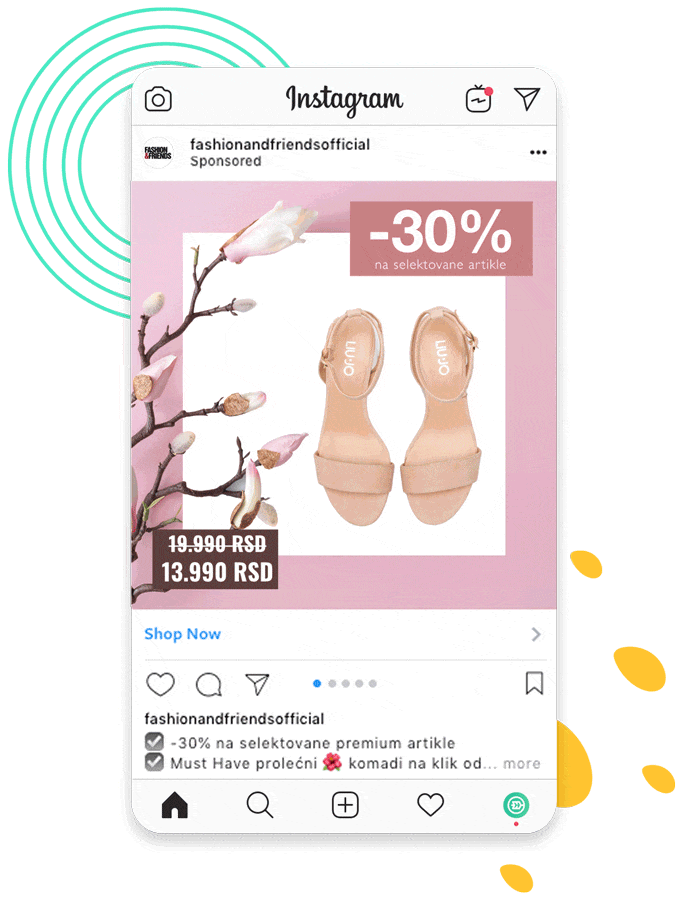
All of this will help you achieve the goals of your ads by making them aesthetically appealing. The human brain responds immediately to beautiful or visually appealing materials. Aesthetically pleasing ads also engage your audience, establish a relationship between your brand and your target audience, and communicate a clear message.
6. Use custom audience
A custom audience refers to a group of people who have already interacted with your business. You can create these audiences using current data and different sources. A custom audience can be from your existing email customer list of people who have previously purchased from you, people who have visited your website or interacted with your Instagram or Facebook page, or a variety of other touchpoints.
They should be based on your customer persona or that fictional representation of your ideal customers.
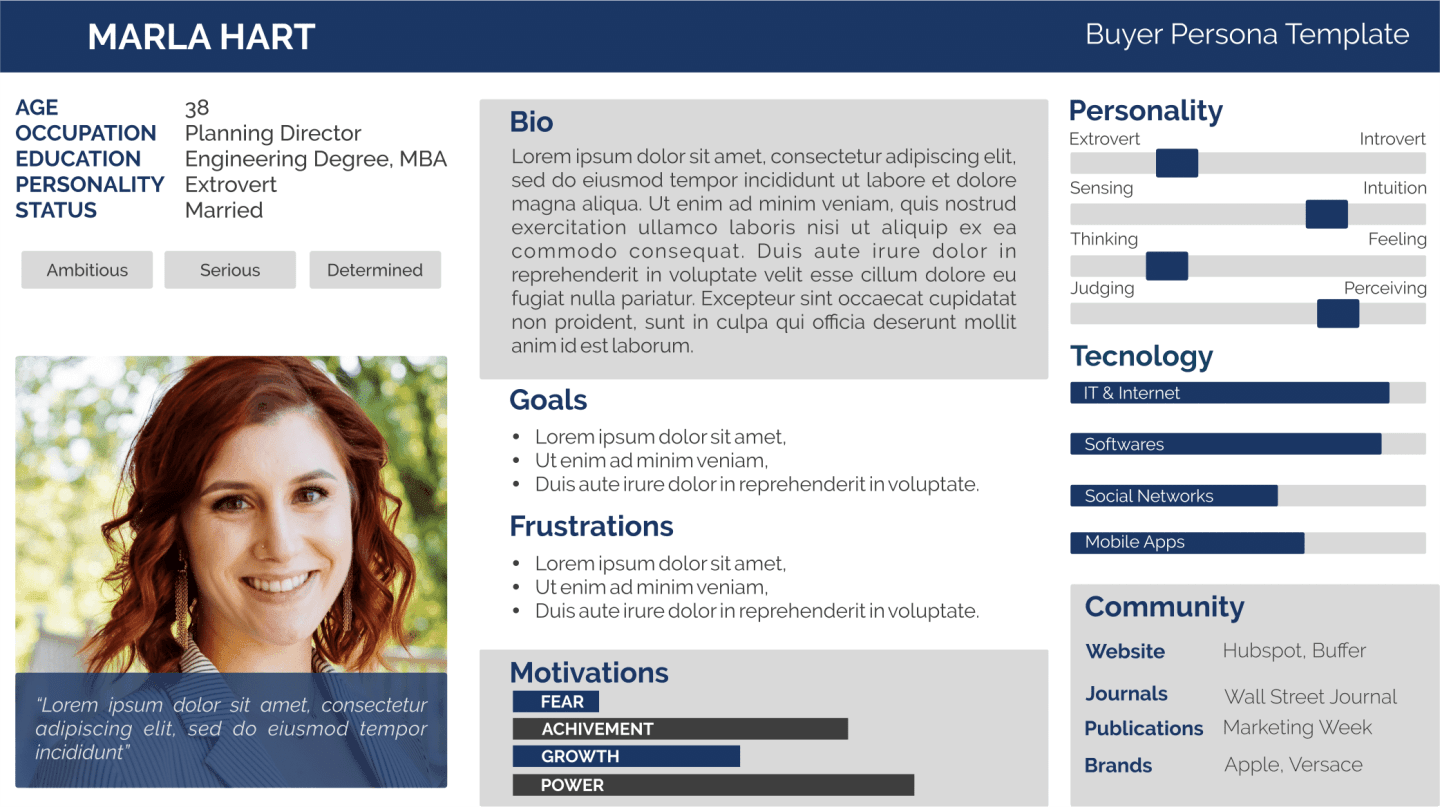
Custom audiences are critical since consumers who have already interacted with your business are considerably more likely to convert and purchase your products or services than a cold audience. They’ve shown higher commitment and interest in your brand. So, they are of higher quality and have a higher level of engagement, resulting in the best advertising outcomes.
So, you should establish advertising custom audiences for each sale funnel and include them in your retargeting ad sets.
7. Test the copy
You should conduct tests to determine whether products are underperforming due to a lack of interest or promotion. It is beneficial to obtain data to support your decisions, receive ideas for further improvement. You also want to have the capacity to evaluate and segment different audiences.
So, try to target a single audience with several creatives to see which works better. You can use dynamic testing to check various creative elements, such as photos and headlines. It will automatically generate combinations optimized for your target audience. Variations may include different formats or templates based on one or more elements.
For instance, you could make five various headlines, each with diverse graphics, location, etc. However, ensure they’re fully diverse so you can optimize testing efficiency.
8. Use retargeting
Retargeting is the process of showing your ads to someone who has previously interacted with your company in some way to keep them interested and moving further into your sales funnel.
Retargeting ads have a ten times higher average click-through rate than regular ads. To create retargeting ads, you can use data from website activity info, app activity info page, content activity data, etc.
Based on your goals and how you target them, there are three main types of retargeting.
Dynamic Retargeting: These are retargeting campaigns based on client activities like viewing or adding to cart but not purchasing to upsell them.
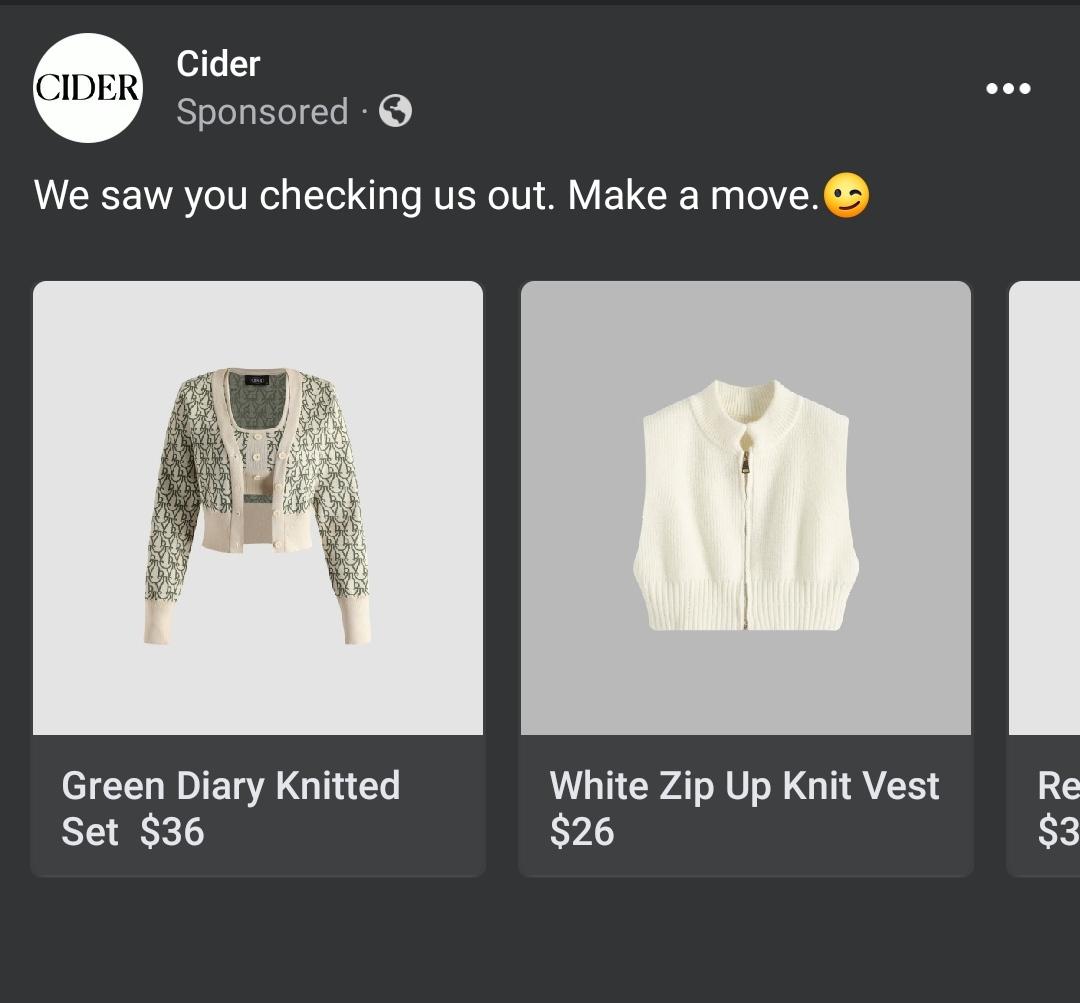
Cider, for instance, uses dynamic product ads to display this retargeting ad in the image. They mention the client’s activity and provide a call to action. The items presented depend on the visitors’ activities.
Engagement Retargeting: These ads leverage activity to show advertising to those who have visited your website, store, or page. The ultimate goals are to grab their attention, join a group or an online community, like your page, etc.
Source Audiences Retargeting: These target people who have never heard of your company but are interested in the same things that your present customers are. The idea is to build new audiences similar to the current one.
Retargeting ads may help you reduce cart abandonment, lower your cost per click, boost your conversion rate, and raise brand recognition.
In Closing
Dynamic product ads, when used correctly, may help you turn intent into a sale, increase conversions, improve engagement, and give your promotional activity a competitive advantage by leveraging data.
They are excellent for scaling and prospecting. Rather than targeting new customers, DPA advertising targets social media users who have demonstrated interest in what you provide on different sites.
Dynamic ads are more effective than regular ads, especially in an ad-saturated society. So, start using them if you haven’t used them just yet. When you start using them, make sure you continue optimizing your ad campaigns to get the best results.
Author Bio:

Baidhurya Mani is the founder of SellCoursesOnline.com . He regularly shares tips, tools, and strategies to help creators and entrepreneurs build a successful online course business.